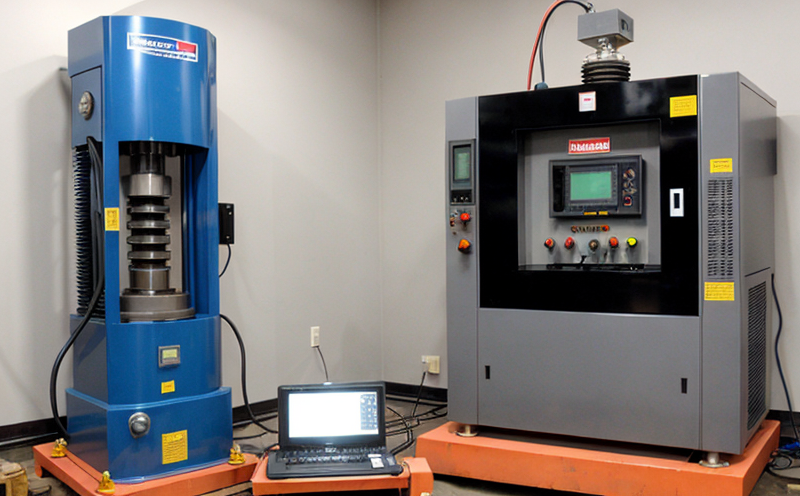MIL STD 810H Method 516 Shock Test
The MIL-STD-810H Method 516.6 test is a critical component of environmental testing for electronic components and systems, ensuring they can withstand the mechanical shock and vibration encountered in military and aerospace applications. This test evaluates how well devices perform under transient stress conditions that could arise from impacts or jolts during transport, deployment, or operation.
The methodology involves subjecting specimens to controlled shock pulses using specialized equipment designed to replicate real-world environments. These shocks are characterized by their peak accelerations, duration, and shape, which can vary widely depending on the specific requirements of the military standard being followed. The primary goal is to assess whether the device under test (DUT) maintains its functionality post-shock.
Method 516.6 includes several types of shock tests such as impulse, sine sweep, and random vibration tests. Each type has distinct parameters aimed at simulating different modes of failure that might occur in various operational scenarios. For instance, impulse testing focuses on short-duration impacts like those caused by dropping equipment or collisions with hard surfaces.
Preparation for the shock test is crucial to ensure accurate results. This includes cleaning and preparing the specimen according to specified procedures, ensuring all fasteners are securely attached, and applying any necessary protective coatings if required by the standard. Proper grounding of the DUT during testing helps prevent interference from external electrical noise which could skew the results.
The test setup typically consists of a drop tower or vibration shaker capable of delivering controlled shock pulses to the specimen. Sensors such as accelerometers measure acceleration levels throughout the event, while cameras capture video footage if visual observation is part of the protocol. After each trial, engineers review this data alongside other relevant metrics like temperature changes and structural integrity checks.
Post-test analysis involves comparing pre- and post-shock performance indicators to determine compliance with specified limits. Common measurements include resistance values for electrical components, mechanical strain readings from strain gauges attached directly onto sensitive areas of the device, and visual inspections looking for cracks or other signs of damage visible through magnification.
Compliance with MIL STD 810H Method 516 ensures that products meet stringent reliability standards demanded by defense contractors and government agencies. By adhering to these rigorous procedures, manufacturers can demonstrate their commitment to producing robust electronics capable of surviving harsh conditions without compromising performance or safety.
Eurolab Advantages
At Eurolab, we pride ourselves on offering world-class electronic testing services that go beyond mere compliance. Our team of experts possesses extensive experience working with MIL STD 810H Method 516 and other related standards, ensuring accurate, repeatable results every time.
- Accurate Results: Using state-of-the-art equipment calibrated to international standards, we provide precise measurements that are crucial for reliable test outcomes.
- Experienced Staff: Our personnel have extensive knowledge of both the theoretical aspects and practical applications of shock testing, allowing us to offer tailored solutions based on your specific needs.
- Comprehensive Reporting: Beyond just passing or failing results, our reports include detailed analyses that help you understand what happened during each test run. This information is invaluable for continuous improvement efforts within your organization.
- Fast Turnaround Times: We understand the importance of timely delivery in many industries, so we strive to minimize lead times without compromising on quality.
We also offer additional services such as failure analysis and reverse engineering if further insights into why a particular component failed are needed. These capabilities set us apart from competitors who may only focus narrowly on meeting regulatory requirements rather than providing comprehensive support throughout the entire lifecycle of your product development process.
International Acceptance and Recognition
- NATO Compliance: The NATO has adopted MIL STD 810H as its standard for environmental testing, recognizing its rigor and applicability across various defense applications.
- European Union Standards: While not mandatory for all EU member states, many choose to follow this guideline due to its widespread acceptance within the industry. Compliance can enhance your product's marketability in Europe.
- International Markets: By conforming to MIL STD 810H Method 516, companies expand their reach into international markets where these standards are valued highly by regulatory bodies and end users alike.
The widespread adoption of MIL STD 810H in military and aerospace sectors makes it a de facto benchmark for durability testing worldwide. This global recognition translates to increased confidence among potential buyers when selecting suppliers who meet this stringent criterion.
Competitive Advantage and Market Impact
- Differentiation: Offering MIL STD 810H compliance demonstrates a commitment to quality that sets you apart from competitors. Customers appreciate knowing they are purchasing products designed to perform reliably under extreme conditions.
- Better Negotiations: With increasing emphasis on sustainability and reliability, being able to tout your adherence to this standard can lead to better contract terms and potentially higher prices for your products.
- Customer Satisfaction: Satisfied customers are more likely to remain loyal patrons, recommending your services and products to others. This positive feedback loop fosters long-term business relationships.
In today's competitive landscape, meeting or exceeding industry standards like MIL STD 810H can be the difference between success and failure. It signals to stakeholders that you are invested in delivering top-notch solutions capable of standing up against any challenge thrown at them.





